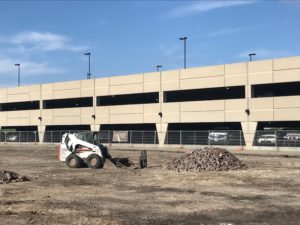Building Blocks For The Future
From our offices in the Livestock Exchange Building we have a front row seat to watch the construction of a new $41 million mixed-use residential development to include 232 luxury apartments. This modern-day facility is being built on the historic site of Kansas City’s Stockyards District, first developed in the late nineteenth century and operated for about 120 years as the epicenter of the U.S. livestock industry. In 1923 alone, 2.6 million cattle were received in these facilities, of which 1.2 million were purchased for the Kansas City area packing houses and the rest were trans-shipped to other destinations around the country.
One innovation the developer used in building the livestock facilities, to enhance the efficiency of storing and moving livestock, and to protect the health of these valuable assets, was to construct the livestock pens with a base of bricks laid on their side and end-to-end, rather than using gravel or mud floors in which bacteria would thrive and invade the transient residents. To this day that brick base still survives after so many years of tough use and flawless performance.
Making way for the next generation development, those bricks now need to be removed from the surface to be restored and processed for re-use, and then they will find a new home in the infrastructure of the new mixed-use residential development arising on the same site. That process has just started, and this morning we happened upon a dirty pile of those old bricks, resting together on the first leg of their journey to a new deployment.
 This dirty old pile of bricks, and the historical setting where we practice law, reminds us that at Krause Law we like to think about building blocks for the future. In our practice with early stage companies, this thinking is designed to help develop a company structure that will withstand the test of time and provide an optimal infrastructure for growth and an eventual exit strategy. Is the capital structure robust enough to facilitate growth, are key employees properly linked to the company’s long-term purposes, are intellectual property assets protected for future value, are financing transactions designed to optimize capital deployment, do contractual relationships fairly address risk factors—these are just a few examples of how current thinking is focused on the future.
This dirty old pile of bricks, and the historical setting where we practice law, reminds us that at Krause Law we like to think about building blocks for the future. In our practice with early stage companies, this thinking is designed to help develop a company structure that will withstand the test of time and provide an optimal infrastructure for growth and an eventual exit strategy. Is the capital structure robust enough to facilitate growth, are key employees properly linked to the company’s long-term purposes, are intellectual property assets protected for future value, are financing transactions designed to optimize capital deployment, do contractual relationships fairly address risk factors—these are just a few examples of how current thinking is focused on the future.
Similar thinking is required in our practice with more established business clients. Often a problem that arises unexpectedly can be transformed into a new opportunity. Likewise, good strategic decisions can help position for future success. Just this past month, we have been working to conclude a $100 million exit transaction for a business that was built on the foundation of a Missouri corporation we originally incorporated for a client twenty years ago. See announcement here. Who could have possibly known, two decades ago, how much wealth this corporation would ultimately create?
We certainly cannot assure this kind of long-term result for each daily decision. Yet we can, along with our clients, use our considerable experience to help think about how to lay the bricks today that will stand the test of time.
